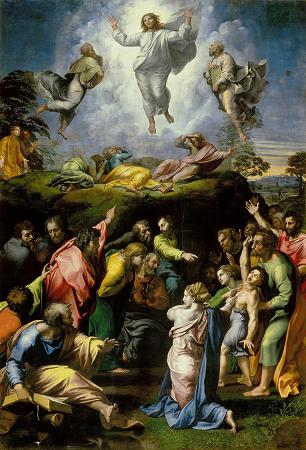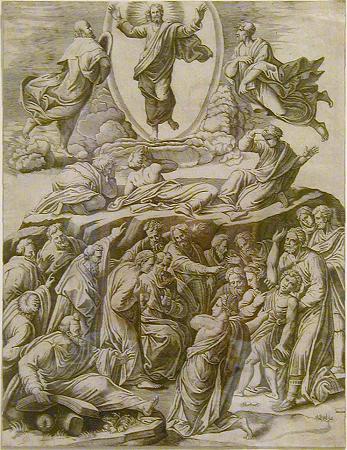Transfiguration of Jesus. The transfiguration of Jesus is a story told in the New Testament when Jesus is transfigured and becomes radiant in glory upon a mountain. The Synoptic Gospels describe it, and the Second Epistle of Peter also refers to it. It has also been hypothesized that the first chapter of the Gospel of John alludes to it. In these accounts, Jesus and three of his apostles, Peter, James, and John, go to a mountain to pray. On the mountain, Jesus begins to shine with bright rays of light. Then the prophets Moses and Elijah appear next to him and he speaks with them. Jesus is then called Son by a voice in the sky, assumed to be God the Father, as in the Baptism of Jesus. Many Christian traditions, including the Eastern Orthodox, Roman Catholic and Anglican churches, commemorate the event in the Feast of the Transfiguration, a major festival. The transfiguration is one of the miracles of Jesus in the Gospels. This miracle is unique among others that appear in the canonical gospels, in that the miracle happens to Jesus himself. Thomas Aquinas considered the transfiguration the greatest miracle in that it complemented baptism and showed the perfection of life in Heaven. The transfiguration is one of the five major milestones in the gospel narrative of the life of Jesus, the others being baptism, crucifixion, resurrection, and ascension. In 2002, Pope John Paul II introduced the Luminous Mysteries in the rosary, which includes the transfiguration. In Christian teachings, the transfiguration is a pivotal moment, and the setting on the mountain is presented as the point where human nature meets God: the meeting place of the temporal and the eternal, with Jesus himself as the connecting point, acting as the bridge between heaven and earth. Moreover, Christians consider the transfiguration to fulfill an Old Testament messianic prophecy that Elijah would return again after his ascension. Gardner states: The very last of the writing prophets, Malachi, promised a return of Elijah to hold out hope for repentance before judgment. Elijah himself would reappear in the Transfiguration. There he would appear alongside Moses as a representative of all the prophets who looked forward to the coming of the Messiah. Christ's redemptive sacrifice was the purpose for which Elijah had ministered while on earth. And it was the goal about which Elijah spoke to Jesus in the Transfiguration. In the Synoptic Gospels, the account of the transfiguration happens towards the middle of the narrative. It is a key episode and almost immediately follows another important element, the Confession of Peter: you are the Christ. The transfiguration narrative acts as a further revelation of the identity of Jesus as the Son of God to some of his disciples. In the gospels, Jesus takes Peter, James, son of Zebedee and his brother John the Apostle with him and goes up to a mountain, which is not named. Once on the mountain, Matthew 17:2 states that Jesus was transfigured before them; his face shining as the sun, and his garments became white as the light. At that point the prophet Elijah representing the prophets and Moses representing the Law appear and Jesus begins to talk to them. Luke states that they spoke of Jesus' exodus which he was about to accomplish in Jerusalem. Luke is also specific in describing Jesus in a state of glory, with Luke 9:32 referring to they saw His glory. Just as Elijah and Moses begin to depart from the scene, Peter begins to ask Jesus if the disciples should make three tents for him and the two prophets. This has been interpreted as Peter's attempt to keep the prophets there longer. But before Peter can finish, a bright cloud appears, and a voice from the cloud states: This is my beloved Son, with whom I am well pleased; listen to him. The disciples then fall to the ground in fear, but Jesus approaches and touches them, telling them not to be afraid. When the disciples look up, they no longer see Elijah or Moses. When Jesus and the three apostles are going back down the mountain, Jesus tells them to not tell anyone the things they had seen until the Son of Man has risen from the dead. The apostles are described as questioning among themselves as to what Jesus meant by risen from the dead. In addition to the principal account given in the synoptic gospels; in 2 Peter 1:16-18, the Apostle Peter describes himself as an eyewitness of his magnificence.
more...






